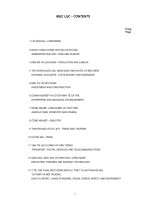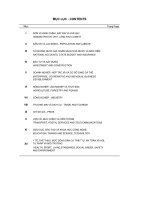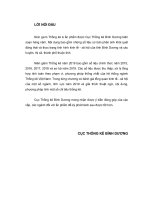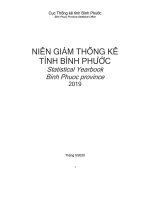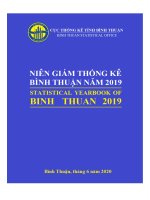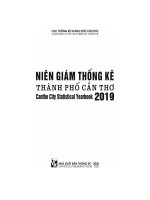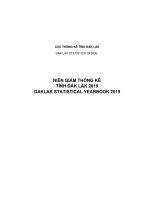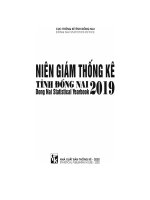Niên giám thống kê tỉnh bạc liêu 2017 bac lieu statistical yearbook 2017
Bạn đang xem bản rút gọn của tài liệu. Xem và tải ngay bản đầy đủ của tài liệu tại đây (3.82 MB, 510 trang )
NIÊN GIÁM THỐNG KÊ
TỈNH BẠC LIÊU 2017
1
Chỉ đạo biên soạn:
ĐỖ THỊ PHƯỢNG
Cục trưởng Cục Thống kê tỉnh Bạc Liêu
Tham gia biên soạn:
PHÒNG THỐNG KÊ TỔNG HỢP
VÀ CÁC PHÒNG NGHIỆP VỤ
Cục Thống kê tỉnh Bạc Liêu
2
LỜI NÓI ĐẦU
Niên giám Thống kê là ấn phẩm tổng hợp số liệu kinh tế - xã hội
hằng năm của ngành Thống kê. Nội dung niên giám là bức tranh tồn
cảnh từ đơn vị hành chính, đất đai, khí hậu, đến tình hình dân số, lao
động và các hoạt động kinh tế - xã hội trong một năm.
Cục Thống kê tỉnh Bạc Liêu biên soạn và phát hành “Niên giám
Thống kê tỉnh Bạc Liêu năm 2017”, bao gồm hệ thống số liệu phản ánh
kết quả đã thực hiện trên các lĩnh vực kinh tế, văn hóa và đời sống xã hội
của địa phương năm 2017, năm gốc 2010 và 3 năm (2014-2016). Sử
dụng hệ thống số liệu giúp các nhà quản lý, nghiên cứu, các tổ chức và
cá nhân có nhu cầu dùng tin phân tích, đánh giá về quá trình phát triển
kinh tế - xã hội địa phương; Các cấp lãnh đạo, các ban, ngành… hoạch
định, lập kế hoạch, quy hoạch đưa ra chủ trương, chính sách và những
giải pháp phát triển kinh tế - xã hội cho năm 2018 và các năm tiếp theo.
Trong cuốn Niên giám này, Cục Thống kê tỉnh Bạc Liêu có chỉnh lý
số liệu theo phương pháp tính và chuyển giá so sánh theo năm gốc 2010.
Do vậy, số liệu có sự điều chỉnh với niên giám năm trước, đề nghị thống
nhất sử dụng số liệu trong cuốn Niên giám năm 2017.
Quá trình biên soạn khó tránh khỏi những hạn chế, thiếu sót, rất
mong nhận được ý kiến đóng góp của quý lãnh đạo và bạn đọc về nội
dung cũng như hình thức đối với ấn phẩm để lần biên soạn sau được
hoàn chỉnh và phong phú hơn.
Mọi góp ý trao đổi, vui lịng liên hệ phòng Tổng hợp, Cục Thống kê
tỉnh Bạc Liêu, số 112, Bà Triệu, phường 3, thành phố Bạc Liêu, tỉnh
Bạc Liêu; điện thoại 02913.949304./.
CỤC THỐNG KÊ TỈNH BẠC LIÊU
3
FOREWORD
Statistical Yearbook is a publication which is aggregated the annual
socio-economic data of Viet Nam Statistical System. Its content includes
the total aspects, from administrative, land and climate to situation of
population, labor and socio-economic activities in a year.
Bac Lieu Statistics Office compiles and publishes the book
“Bac Lieu Statistical Yearbook 2017” which includes the data system
reflecting the results achieved in the fields of economics, culture and social
life in the year 2017, the baseline data 2010 and 3 years (2014-2016).
Using the data system to help managers, researchers, organizations and
individuals wishing to use information to analyze and assess the local
socio-economic development process; The leaders, departments, sectors...
make planning, give guidelines, policies and solutions for socio-economic
development for 2018 and the following years.
In this yearbook, Bac Lieu Statistical Office has revised the data
according to the method of calculating and transferring the comparative
prices by the year 2010. Therefore, the data was adjusted with the
previous yearbook, statistical data users should use the data in this 2017
Yearbook.
In the process of compiling, mistake is unavoidable. We are looking
forward to receiving comments and ideas from the leaders and readers in
both content and form of publications so that statistical yearbook is more
complete and better in the next release.
If there is any issue in process of using, please feel free to contact
Integrated Division, the Bac Lieu Statistics Office, located at 112, Ba Trieu,
Ward 3, Bac Lieu City, Bac Lieu Province; Telephone: 02913.949.304./.
BAC LIEU STATISTICS OFFICE
4
MỤC LỤC
CONTENT
Trang
Page
Lời nói đầu
Foreword
3
4
Tổng quan kinh tế - xã hội tỉnh Bạc Liêu năm 2017
Overview on socio-economic situation in Bac Lieu province in 2017
7
15
Đơn vị hành chính, đất đai và khí hậu
Administrative unit, land and climate
25
Dân số và lao động - Population and Labour
43
Tài khoản quốc gia và ngân sách Nhà nước
National accounts and State budget
93
Đầu tư và xây dựng - Investment and Construction
129
Doanh nghiệp, hợp tác xã và cơ sở SXKD cá thể
Enterprise, cooperative and individual business establishment
159
Nông nghiệp, lâm nghiệp và thủy sản
Agriculture, forestry and fishing
267
Công nghiệp - Industry
335
Thương mại và du lịch - Trade and tourism
359
Chỉ số giá - Price index
379
Vận tải, bưu chính và viễn thơng
Transport, postal services and tele-communications
405
Giáo dục, đào tạo và khoa học, công nghệ
Education, training and science, technology
425
Y tế, thể thao, mức sống dân cư, trật tự, an toàn xã hội, tư pháp và môi trường
Health, sport, living standards, social order, safety and environment
473
5
6
TỔNG QUAN KINH TẾ - XÃ HỘI TỈNH BẠC LIÊU
NĂM 2017
1. Tăng trưởng kinh tế
Tổng sản phẩm trong tỉnh (GRDP) năm 2017 ước tính tăng 6,50%
so với năm 2016. Trong mức tăng 6,50% của tồn nền kinh tế, khu vực
nơng, lâm nghiệp và thủy sản tăng 3,45%, cao hơn mức tăng 2,87% của
năm 2016, đóng góp 1,49 điểm phần trăm vào mức tăng chung; khu vực
công nghiệp và xây dựng tăng 10,01%, cao hơn mức tăng 8,46% của
năm trước, đóng góp 1,48 điểm phần trăm; khu vực dịch vụ tăng 8,71%,
cao hơn mức tăng 7,23% của năm 2016, đóng góp 3,50 điểm phần trăm;
thuế nhập khẩu, thuế sản phẩm trừ trợ cấp sản phẩm tăng 1,71%, đóng
góp 0,03 điểm phần trăm.
Tổng sản phẩm trong tỉnh (GRDP) theo giá hiện hành đạt 33.534,64
tỷ đồng; GRDP bình qn đầu người ước tính đạt 37,50 triệu đồng
(tương đương 1.474 USD), tăng 3,41 triệu đồng (tăng 116 USD) so với
năm trước. Cơ cấu nền kinh tế năm 2017, khu vực nông, lâm nghiệp và
thủy sản chiếm tỷ trọng 42,40%; khu vực công nghiệp và xây dựng
chiếm 14,82%; khu vực dịch vụ chiếm 41,14%; thuế sản phẩm trừ trợ
cấp sản phẩm chiếm 1,65%.
2. Thu, chi ngân sách và bảo hiểm
Năm 2017, tổng thu ngân sách Nhà nước trên địa bàn tỉnh Bạc Liêu
ước đạt 5.417.76 tỷ đồng (thu cân đối ngân sách Nhà nước là 2.851,95 tỷ
đồng; thu bổ sung từ ngân sách cấp trên 2.565,81 tỷ đồng) bằng 97,32%
so với cùng kỳ.
Tổng chi ngân sách trên địa bàn tỉnh Bạc Liêu là 5.616,32 tỷ đồng,
tăng 6,59% so với cùng kỳ. Trong đó, chi đầu tư phát triển 1.737,52 tỷ
đồng, tăng 28,66%; chi thường xuyên 3.877,79 tỷ đồng, tăng 22,94%; chi
bổ sung quỹ dự trữ tài chính 01 tỷ đồng, bằng 100% so với cùng kỳ…
7
Tổng số thu bảo hiểm năm 2017 đạt 1.094 tỷ đồng, tăng 40,47% so
với năm 2016, trong đó: thu bảo hiểm xã hội đạt 473 tỷ đồng, tăng
13,14%; bảo hiểm y tế là 592 tỷ đồng, tăng 76,49%; bảo hiểm thất
nghiệp là 30 tỷ đồng, tăng 15,32%. Tổng số chi bảo hiểm năm 2017 là
1.144 tỷ đồng, tăng 23,01% so với cùng kỳ, trong đó chi bảo hiểm xã hội
là 350 tỷ đồng, tăng 3,86%; chi bảo hiểm y tế 773 tỷ đồng, tăng 35,61%;
chi bảo hiểm thất nghiệp 21 tỷ đồng, giảm 8,70%.
3. Đầu tư - xây dựng
Tổng vốn đầu tư thực hiện toàn xã hội tỉnh Bạc Liêu năm 2017 theo
giá hiện hành đạt 14.203,86 tỷ đồng, tăng 16,35% so với năm 2016 và
bằng 42,36% GRDP, bao gồm: Vốn khu vực Nhà nước đạt 2.362,05 tỷ
đồng (chiếm 16,63% tổng vốn đầu tư thực hiện toàn xã hội), giảm
5,88%; khu vực ngoài nhà nước đạt 11.773,05 tỷ đồng (chiếm 82,89%),
tăng 22,13%; khu vực có vốn đầu tư nước ngồi đạt 68,76 tỷ đồng,
(chiếm 0,48%), tăng 18,55%.
Về thu hút đầu tư trực tiếp nước ngồi: Năm 2017, tỉnh khơng có
dự án vốn đầu tư trực tiếp nước ngoài mới được triển khai. Nguồn vốn
đầu tư trực tiếp nước ngoài chủ yếu thực hiện các dự án chuyển tiếp từ
những năm trước.
4. Chỉ số giá tiêu dùng, chỉ số giá vàng và đô la Mỹ
Năm 2017, trong điều kiện giá một số mặt hàng thiết yếu tăng trở
lại, nhưng với sự quan tâm chỉ đạo của các cấp, các ngành có liên quan
nhằm thực hiện đồng bộ các biện pháp từ sản xuất, tiêu dùng, điều hịa
cung cầu, bình ổn giá cả... nên lạm phát đã được kiểm soát trong trong
giới hạn cho phép.
CPI bình quân năm 2017 tăng 4,82% so với bình quân năm 2016.
Chỉ số giá tiêu dùng (CPI) tháng 12/2017 tăng 4,69% so với tháng
12/2016, bình quân mỗi tháng tăng 0,38%.
Chỉ số giá vàng tháng 12 năm 2017 tăng 7,12% so với cùng kỳ năm
trước; bình quân năm 2017 tăng 3,27% so với bình quân năm 2016.
8
Chỉ số giá đô la Mỹ tháng 12 năm 2017 tăng 0,46% so với tháng
12/2016; bình quân năm 2017 tăng 1,57% so với bình quân năm 2016.
5. Doanh nghiệp, hợp tác xã và cơ sở kinh doanh cá thể phi
nông nghiệp
Số doanh nghiệp thực tế hoạt động tại thời điểm 31/12/2016 trên
địa bàn tỉnh Bạc Liêu là 1.226 doanh nghiệp, tăng 41,24% so với năm
2015 (tức là tăng 358 doanh nghiệp), trong đó: doanh nghiệp ngồi nhà
nước chiếm 98,86%/tổng số doanh nghiệp, với 1.212 doanh nghiệp,
tăng 41,75%; doanh nghiệp có vốn đầu tư nước ngoài là 6 doanh
nghiệp, tăng 20%; số lượng doanh nghiệp nhà nước không biến động
với 8 doanh nghiệp.
Lao động làm việc trong toàn bộ khu vực doanh nghiệp có 27.447
người, tăng 37,06% so với cùng thời điểm năm 2015, trong đó: lao động
ở khu vực doanh nghiệp ngoài nhà nước là 24.494 người, tăng 43,42%;
lao động khu vực doanh nghiệp có vốn đầu tư nước ngồi là 2.264 người,
tăng 4,33%; riêng lao động làm việc trong khu vực doanh nghiệp
nhà nước chỉ có 689 người, giảm 11,33%.
Năm 2017, tồn tỉnh Bạc Liêu có 66 hợp tác xã, tăng 13,79% so với
năm 2015 (tăng 8 hợp tác xã). Số lao động làm việc trong hợp tác xã là
3.085 người, tăng 27,43%.
Số cơ sở kinh doanh cá thể phi nông, lâm nghiệp và thủy sản trên
địa bàn tỉnh gồm có 57.684 cơ sở, tăng 3,99% so với năm 2016 (tăng
2.214 cơ sở).
6. Kết quả sản xuất, kinh doanh một số ngành, lĩnh vực
a. Nông, lâm nghiệp và thủy sản
Sản lượng lương thực có hạt của tồn tỉnh đạt 1.067,91 nghìn tấn,
tăng 7,07% so với cùng kỳ năm 2016 (tương đương tăng 70,56 nghìn
tấn). Trong đó, sản lượng lúa đạt 1.067,09 nghìn tấn, tăng 7,08% (tương
đương tăng 70,52 nghìn tấn): Sản lượng lúa Đơng xn đạt 333,25 nghìn
9
tấn; lúa Hè thu 570,56 nghìn tấn; lúa (thu đơng) đạt 163,27 nghìn tấn.
Sản lượng ngơ (bắp) là 825 tấn, tăng 4,43% so với cùng kỳ.
Năm 2017, diện tích trồng rừng mới tập trung của toàn tỉnh Bạc
Liêu đạt 129,18 ha, giảm 8,38% so với cùng kỳ. Toàn bộ diện tích rừng
mới là rừng phịng hộ. Sản lượng gỗ khai thác đạt 4.010 m3, tăng 3,35%
so với cùng kỳ.
Năm 2017, sản lượng thủy sản đạt 322,68 nghìn tấn, tăng 6,68% so
với năm 2016. Sản lượng thủy sản nuôi trồng đạt 210,78 nghìn tấn, tăng
7,99%; sản lượng thủy sản khai thác 111,87 nghìn tấn, tăng 4,28%.
Trong năm, tỉnh tiếp tục tổ chức thực hiện Đề án “Tái cơ cấu ngành thủy
sản tỉnh Bạc Liêu đến năm 2020, định hướng 2030 theo hướng nâng cao
giá trị gia tăng và phát triển bền vững” và “Kế hoạch nuôi Artemia trên
địa bàn tỉnh Bạc Liêu giai đoạn 2016-2020”; “Kế hoạch phòng chống
dịch bệnh đối với thủy sản năm 2018”. Với mục tiêu đưa “Bạc Liêu trở
thành trung tâm công nghiệp tôm của cả nước” theo chỉ đạo của Thủ
tướng Chính phủ, dự án xây dựng Khu nông nghiệp ứng dụng công nghệ
cao phát triển tôm Bạc Liêu đang được tỉnh quan tâm đầu tư.
b. Cơng nghiệp
Chỉ số sản xuất tồn ngành cơng nghiệp năm 2017 tăng 8,92% so với
năm 2016. Trong đó: Chỉ số ngành khai khống giảm 38,07%; ngành cơng
nghiệp chế biến, chế tạo tăng 7,94%; ngành sản xuất và phân phối điện,
khí đốt, hơi nước và điều hịa khơng khí, chỉ số tăng 20,76%; và cuối cùng
là ngành cung cấp nước, hoạt động quản lý xử lý rác thải tăng 7,51%.
Năm 2017, một số sản phẩm công nghiệp chủ yếu trên địa bàn
tỉnh Bạc Liêu sản lượng tăng cao so với năm trước: Thủy sản đông lạnh
xuất khẩu đạt 68.276 tấn, tăng 6,99%; muối Iốt 8.250 tấn, tăng 10%;
điện thương phẩm, sản lượng 903,98 triệu kwh, tăng 8,79%; nước
thương phẩm 8.588,24 triệu m3, tăng 7,24%; bia sản xuất 49,20 triệu lít,
tăng 6,84%...
10
c. Thương mại, vận tải và dịch vụ
Năm 2017, tổng mức bán lẻ hàng hóa và doanh thu dịch vụ tiêu
dùng trên địa bàn tỉnh Bạc Liêu đạt 42.573 tỷ đồng, tăng 11,40% so với
năm trước.
Khối lượng vận chuyển hành khách trong năm 2017 đạt 101,27
triệu hành khách, tăng 12,02% so với cùng kỳ; luân chuyển đạt 2.351,83
triệu hành khách.km, tăng 11,76% so với cùng kỳ.
Vận chuyển hàng hóa trong năm 2017 đạt 13,14 triệu tấn, tăng
10,04% so với năm trước; luân chuyển 644,53 triệu tấn.km, tăng 9,57%
so với cùng kỳ.
Doanh thu du lịch năm 2017 tỉnh Bạc Liêu đạt 2.204 tỷ đồng, tăng
8,09% so với cùng kỳ. Số lượt khách nghỉ qua đêm có 524.935 lượt
người, tăng 15% so với cùng kỳ; khách trong ngày 1.894.710 lượt người,
tăng 14,46%; khách du lịch do các cơ sở lưu trú phục vụ có 2.419.646
lượt người, tăng 14,57%; số lượt khách do các cơ sở lữ hành phục vụ là
1.110 lượt người, tăng 25% so với cùng kỳ.
7. Một số vấn đề văn hóa - xã hội
a. Dân số, lao động và việc làm
Dân số trung bình năm 2017 của tỉnh Bạc Liêu đạt 894.257 người,
tăng 2.616 người, tương đương tăng 0,29% so với năm 2016, bao gồm
dân số thành thị 262.020 người, chiếm 29,30%; dân số nông thôn
632.237 người, chiếm 70,70%; dân số nam 447.115 người, chiếm 49,99%;
dân số nữ 447.142 người, chiếm 50,01%.
Năm 2017, lực lượng lao động từ 15 tuổi trở lên của tỉnh Bạc Liêu
đạt 581.394 người, tăng 2.069 người so với năm 2016; Tổng số lao động
từ 15 tuổi trở lên đang làm việc trong năm 2017 là 564.529 người, tăng
3.163 người so với năm 2016, trong đó: Khu vực kinh tế nhà nước có
30.215 người, chiếm 5,35%; khu vực kinh tế ngoài nhà nước là 526.862
người, chiếm tỷ trọng cao nhất với 93,33%; số lao động làm việc trong
khu vực đầu tư nước ngoài là 7.452 người, chiếm 1,32%; tỷ lệ lao động
11
từ 15 tuổi trở lên đang làm việc đã qua đào tạo có bằng cấp, chứng chỉ
đạt 42,63% (cao hơn mức 41,49% của năm 2016).
Tỷ lệ thất nghiệp của lực lượng lao động trong độ tuổi năm 2017 là
2,92%, trong đó: Tỷ lệ nam là 2,30%; nữ 3,53%; khu vực thành thị
3,90%; khu vực nông thôn 2,52%. Tỷ lệ thiếu việc làm của lực lượng lao
động trong độ tuổi là 0,67%; tỷ lệ nam thiếu việc làm chiếm 0,52%; tỷ lệ
nữ là 0,82%; khu vực thành thị 0,60%; khu vực nơng thơn 0,70%.
b. Giáo dục
Năm 2016-2017, tồn tỉnh có 88 trường mầm non, bằng 100% so
với năm học trước; 213 trường phổ thông, tăng 02 trường, bao gồm: 129
trường tiểu học, tăng 01 trường; 63 trường trung học cơ sở, tăng 01
trường; 15 trường trung học phổ thông; 01 trường phổ thông cơ sở và
5 trường trung học cơ sở.
Năm học 2016-2017, số giáo viên mẫu giáo là 1.691 giáo viên, tăng
11,40% so với năm học 2015-2016; số giáo viên phổ thông giảng dạy là
6.426 giáo viên, tăng 0,71% (tăng 45 giáo viên), bao gồm: 3.268 giáo
viên tiểu học, tăng 0,31% (tăng 10 giáo viên); 2.350 giáo viên trung học
cơ sở, tăng 1,38% (tăng 32 giáo viên); 808 giáo viên trung học phổ
thông, tăng 0,37% (tăng 3 giáo viên). Phần lớn giáo viên phổ thơng đều
có trình độ đào tạo đạt chuẩn và trên chuẩn.
Trong năm học 2016-2017, toàn tỉnh có 30.065 trẻ em đi học mẫu
giáo, tăng 0,42% so với năm học trước; 137.397 học sinh phổ thông, tăng
0,10% so với năm học trước, bao gồm: 73.166 học sinh tiểu học, tăng
0,16%; 47.907 học sinh trung học cơ sở, giảm 1,25%; 16.324 học sinh
trung học phổ thơng, tăng 3,94%.
Tồn tỉnh có: 01 trường đại học, số giáo viên là 287 giáo viên, tăng
34,11% so với năm 2016; số sinh viên đại học có 2.721 sinh viên, giảm
13,48% so với năm 2016; 03 trường cao đẳng, với 207 giáo viên, tăng
2,04 lần so với năm 2016; số sinh viên cao đẳng có 1.949 sinh viên, tăng
2,07 lần so với năm 2016.
12
c. Y tế
Số cơ sở khám chữa bệnh do địa phương quản lý là 75 cơ sở, trong
đó có 10 bệnh viện, 01 phòng khám đa khoa khu vực và 64 trạm y tế xã,
phường. Số giường bệnh do địa phương quản lý là 2.344 giường bệnh,
giảm 1,47% so với năm 2016, trong đó: 2.060 giường trong các bệnh
viện, tăng 0,44%; 10 giường bệnh tại phòng khám đa khoa khu vực,
giảm 71,43% so với năm 2016; 274 giường bệnh tại trạm y tế xã,
phường, giảm 1,44%. Số giường bệnh do địa phương quản lý bình quân
1 vạn dân năm 2017 là 26,17 giường bệnh, giảm so với bình quân 26,64
giường bệnh của năm 2016.
Năm 2017, số nhân lực y tế do địa phương quản lý là 3.794 người,
tăng 17,90% so với năm 2016, trong đó: 3.130 nhân lực làm việc trong
ngành Y, tăng 14,57%; 664 người làm việc trong ngành Dược, tăng
36,63%. Số bác sỹ bình quân 1 vạn dân tăng từ 8,25 người trong năm
2016 lên 8,84 người của năm 2017.
Tỷ lệ trẻ em dưới 5 tuổi bị suy dinh dưỡng cân nặng theo tuổi là
13,20%; tỷ lệ trẻ em dưới 5 tuổi bị suy dinh dưỡng chiều cao theo tuổi là
13,40%; tỷ lệ trẻ em dưới 5 tuổi bị suy dinh dưỡng cân nặng theo chiều
cao là 15,20%;
d. Đời sống dân cư
Đời sống của dân cư trên địa bàn tỉnh Bạc Liêu tiếp tục được cải
thiện. Một số chỉ tiêu về mức sống dân cư trong năm 2017 đều theo
hướng tích cực và tăng so với năm 2016.
Tỷ lệ hộ nghèo tiếp cận đa chiều đã giảm từ 12,24% của năm 2016
xuống còn 8,42% trong năm 2017; thu nhập bình quân đầu người mỗi
tháng theo giá hiện hành đạt 2.470 nghìn đồng, tăng 9,45% so với năm
2016; Tỷ lệ dân số đô thị được cung cấp nước sạch đạt 68,92%; tỷ lệ hộ
được sử dụng nguồn nước hợp vệ sinh là 99,85%; tỷ lệ hộ dùng hố xí
hợp vệ sinh đạt 53%.
13
Năm 2017, do biến đổi khí hậu làm thời tiết diễn biến phức tạp, sạt
lở, mưa giông kèm theo lốc xốy gây thiệt hại cho nơng dân. Trong năm,
thiên tai làm 01 người bị thương; 3 nhà bị sập đổ, cuốn trôi; 4 nhà bị ngập
nước, sạt lở, tốc mái và hư hại; 4.069 ha lúa bị ngập úng và hư hỏng.
e. Trật tự an toàn xã hội
Năm 2017, trên địa bàn tỉnh Bạc Liêu đã xảy ra 53 vụ tai nạn giao
thông, (gồm 51 vụ tai nạn giao thông đường bộ và 02 vụ tai nạn đường
thủy), giảm 10,17% so với năm 2016. Tai nạn đã làm 31 trường hợp tử
vong, giảm 16,22%; 43 trường hợp bị thương, giảm 24,56% so với cùng kỳ.
Trong năm, toàn tỉnh xảy ra 24 vụ cháy, nổ, làm nhiều người bị
thương, gây thiệt hại 6.761 triệu đồng, khơng có trường hợp tử vong. So
với năm trước, số vụ cháy, nổ tăng 71,43%, thiệt hại tăng 31,28%.
Khái quát lại: Tình tình hình kinh tế - xã hội của tỉnh năm 2017 về
cơ bản đã hoàn hoàn thành một số chỉ tiêu theo kế hoạch. Kinh tế vĩ mô
ổn định; tăng trưởng đạt mục tiêu đề ra; lạm phát được kiểm soát trong
giới hạn cho phép; công nghiệp chế biến, chế tạo tăng cao; các ngành
dịch vụ đạt khá; môi trường đầu tư, kinh doanh tiếp tục được cải thiện;
tỷ lệ hộ nghèo; tỷ lệ thất nghiệp và thiếu việc làm thấp hơn năm trước.
Bên cạnh những kết quả đã đạt được, nền kinh tế của tỉnh Bạc Liêu
vẫn cịn đối mặt với nhiều khó khăn, thách thức như: Biến đổi khí hậu
làm thời tiết diễn biến phức tạp, sạt lở, mưa giông kèm theo lốc xoáy gây
thiệt hại cho hoạt động sản xuất kinh doanh; đối với sản xuất nông
nghiệp, giá heo hơi giảm mạnh, dịch cúm gia cầm phát sinh tác động
tiêu cực đến hoạt động chăn ni; năng lực cạnh tranh cịn hạn chế;
công tác thu hút vốn đầu tư trực tiếp nước ngoài chưa tương xứng với
tiềm năng của tỉnh; tiến độ thu ngân sách và giải ngân vốn đầu tư còn
thấp so với kế hoạch...
14
OVERVIEW ON SOCIO-ECONOMIC SITUATION
IN BAC LIEU PROVINCE IN 2017
1. Economic growth
Gross regional domestic product (GRDP) in 2017 was estimated to
increase 6.50% compared to 2016. Of which, the agriculture, forestry and
fishery sector rose by 3.45%, higher than the rate of 2.87% in 2016,
contributing 1.49 percentage points to the overall growth rate; the
industry and construction went up 10.01%, higher than the level of
8.46% in the previous year, contributing 1.48 percentage points; the
service sector grew 8.71%, higher than the figure of 7.23% in the
previous year, contributing 3.50 percentage points; the product taxes
less subsidies on production expanded 1.71%, contributing 0.03
percentage points.
GRDP at current prices reached 33,534.64 billion VND; GRDP per
capita was estimated to reach 37.50 million VND (equivalent to 1,474
USD), an increase of 3.41 million VND (116 USD) compared to the
previous year. In terms of economic structure in 2017, the agriculture,
forestry and fishery sector accounted for 42.40%; the industry and
construction sector shared 14.82%; the service sector made up 41.14%;
the product taxes less subsidies on production represented 1.65%.
2. State budget revenues, expenditures and insurance
In 2017, total State budget revenues in Bac Lieu province was
estimated to reach 5,417.76 billion VND (State budget balancing
revenues was 2,851.95 billion VND; transfers from the superior budget
was 2,565.81 billion VND) which equaled 97.32% in comparison with
the same period.
Total budget expenditure in the province was 5,616.32 billion
VND, an increase of 6.59% over the same period. Of which,
15
development investment expenditures was 1,737.52 billion VND, a rise
of 28.66%; recurrent expenditures reached 3,877.79 billion VND, a
growth of 22.94%; transfer to financial reserve fund was 01 billion VND,
equivalent to 100% over the same period.
Total insurance revenues in 2017 reached 1,094 billion VND,
increased 40.47% compared to 2016, of which: the social insurance
revenue reached 473 billion VND, an increase of 13.14%; the health
insurance revenue was 592 billion VND, a growth of 76.49%; the
unemployment insurance revenue gained 30 billion VND, a rise of
15.32%. Total insurance expenditures in 2017 reached 1,144 billion
VND, went up 23.01% over the same period, of which the social
insurance expenditure was 350 billion VND, an increase of 3.86%; the
health insurance expenditure was 773 billion VND, an increase of
35.61%; the unemployment insurance revenue was 21 billion VND, a
decline of 8.70%.
3. Investment - construction
Total implementation investment in Bac Lieu province at current
prices reached 14,203.86 billion VND in 2017, increased 16.35% over 2016
and equaled 42.36% of GRDP, including: the State sector’s investment
gained 2,362.05 billion VND (accounting for 16.63% of the total
implementation investment), decreased by 5.88%; the non-state sector’s
investment was 11,773.05 billion VND (making up 82.89%), an increase of
22.13%; the foreign direct investment (FDI) sector’s investment was 68.76
billion VND, (accounting for 0.48%), a rise of 18.55%.
In terms of FDI attraction: in 2017, there was no new FDI project
deployed in the province. The source of FDI was mainly transferred from
previous year’s projects.
4. Consumer price index, gold price index, and USD price index
In 2017, in the context the prices of some essential commodities
increased again, however, thanks to attention and direction of authorities
16
at all levels and sectors in synchronously implementing measures from
production, consumption, harmonization of supply and demand, price
stability… so inflation was controlled within permitted limits.
Average consumer price index (CPI) in 2017 increased 4.82%
compared to that in 2016. CPI in December 2017 rose by 4.69% in
comparison with the same period in 2016; each month grew 0.38% on
average.
Gold price index in December 2017 expanded 7.12% over the same
previous last year; average gold price index in 2017 increased 3.27%
compared to that figure in 2016.
USD price index in December 2017 went up 0.46% over December
2016; average USD price index in 2017 increased 1.57% in comparison
with that in 2016.
5. Enterprise, co-operatives and non-farm individual business
establishments
The number of enterprises actually in active as of December 31st,
2016 in Bac Lieu province was 1,226 enterprises, an increase of
41.24% over 2015 (equivalent to a rise of 358 enterprises), of which:
the Non-state enterprises made up 98.86% of the total enterprises, with
1,212 enterprises, increased by 41.75%; the number of the FDI
enterprises was 6 enterprises, went up 20%; the number of the Stateowned enterprises remained unchanged with 8 enterprises.
The number of employees in province’s enterprises was 27,447
persons, increased 37.06% over the same period in 2015, of which: the
number of employees in the Non-state enterprises was 24,494 persons,
an increase of 43.42%; the number of employees in the FDI enterprises
reached 2,264 persons, a rise of 4.33%; particularly, the number of
employees in the State-owned enterprises was only 689 persons, a
decrease of 11.33%.
17
In 2017, the province of Bac Lieu had 66 co-operatives, increased
by 13.79% compared to 2015 (an increase of 8 cooperatives). The
number of employees working in co-operatives was 3,085 persons, an
increase of 27.43%.
The number of non-farm individual business establishments in the
province included 57,684 establishments, rose by 3.99% over 2016 (an
increase of 2,214 establishments).
6. Results of production and business in a number of economic
activities, sectors
a. Agriculture, forestry and fishery
Production of cereals in the province reached 1,067.91 thousand
tons, increased by 7.07% over the same period in 2016 (equivalent to an
increase of 70.56 thousand tons). Of which, production of paddy was
1,067.09 thousand tons, went up 7.08% (equivalent to a rise of 70.52
thousand tons): production of winter-spring paddy was 333.25 thousand
tons; production of summer-autumn paddy was 570.56 thousand tons;
production of traditional paddy reached 163.27 thousand tons. Production
of maize was 825 tons, expanded 4.43% over the same period.
In 2017, the area of newly concentrated planted forests in Bac Lieu
province reached 129.18 ha, a decline of 8.38% over the same period. All
area of newly planted forest was protection forest. Production of timber
reached 4,010 m3, increased by 3.35% compared to the same period.
In 2017, fishery production reached 322.68 thousand tons,
increased by 6.68% over 2016. Aquaculture production was 210.78
thousand tons, an increase of 7.99%; production of aquatic capture was
111.87 thousand tons, went up 4.28%. During the year, the province
continued to implement the project “Reconstructing the fishery in Bac
Lieu province to 2020, vision to 2030 towards enhancing added value
and sustainable development” and “Plan for farming Artemia in Bac
Lieu province in the period 2016-2020”; “Disease prevention plan for
18
fishery in 2018”. With the objective of boosting “Bac Lieu province as
the center of shrimp industry in the whole country” under the direction
of the Prime Minister, the project on constructing the agricultural zone
applying high technology in developing the shrimp industry in Bac Lieu
province was received full attention of province’s authorities.
b. Industry
Index of industrial production of the whole industrysectorin 2017
increased 8.92% compared to 2016. Of which: index of the mining and
quarrying decreased 38.07%; index of the manufacturing went up 7.94%;
index of the production and distribution of electricity, gas, steam and air
conditioning rose 20.76%; and the water supply, sewage and waste
management and remediation services increased 7.51%.
In 2017, production of some major industrial products in Bac Lieu
province was higher than the previous year: frozen fishery products for
export reached 68,276 tons, an increase of 6.99%; iodine salt was 8,250
tons, a rise of 10%; output of commercial electricity was 903.98 million
kwh, a growth of 8.79%; running water was 8,588.24 million m3, an
increase of 7.24%; production of beer was 49.20 million liters, a rise of
6.84%...
c. Trade, transport and services
In 2017, gross retail sales of goods and services in the province
reached 42,573 billion VND, increased 11.40% compared to the previous
year.
Number of passengers carried in 2017 reached 101.27 million
persons, went up 12.02% in comparison with the same period; number of
passengers traffic was 2,351.83 million persons.km, rose 11.76%
compared to the same period.
In 2017, the volume of freight carried reached 13.14 million tons, an
increase of 10.04% over the previous year; the volume of freight traffic was
644.53 million tons.km, a growth of 9.57% over the same period.
19
Turnover of tourism in 2017 in Bac Lieu province reached 2,204
billion VND, increased 8.09% compared to the same period. Number of
overnight visitors was 524,935 persons, increased 15% over the same
period; number of daily visitors was 1,894.710 persons, grew 14.46%;
the number of tourists served by accommodation establishments was
2,419.646 persons, a growth of 14.57%. Number of turnover of travelling
was 1,110 persons, grew 20% over the same period.
7. Cultural and social issues
a. Population, labor and employment
The average population in 2017 in Bac Lieu province was at
894,257 persons, increased by 2,616 persons, equivalent to an increase of
0.29% in comparison with 2016, of which the urban population was
262,020 persons, accounting for 29.30%; the rural population was
632,237 persons, making up 70.70%; the male population was 447,115
persons, representing 49.99%; the female population was 447,142
persons, accounting for 50.01%.
In 2017, the labor force aged 15 years and over of Bac Lieu
province reached 581,394 persons, increased by 2,069 persons in
comparison with 2016; Labor force aged 15 years and over working in
the economic activities in 2017 was 564,529 persons, an increase of
3,163 persons against 2016, of which labor in the state sector was 30,215
persons, accounted for 5.35%; labor in the non-state sector was 526,862
persons, made up the highest share with 93.33%; labor in the FDI sector
was 7,452 persons, made up 1.32%; The percentage of trained employed
workers with diplomas and certificates aged 15 and over reached 42.63%
(higher than the figure 41.49% of the previous year).
The unemployment rate of labor force in working age was 2.92% in
2017, of which the male made up 2.30%; the female was 3.53%; the rate
of urban areas was 3.90% and the rate of rural areas was 2.52%. The
underemployment rate of labor force in working age was 0.67%; of
which the underemployment rate of male and female labor force was
0.52% and 0.82%, respectively; the corresponding rate the urban and
rural area was 0.60% and 0.70%.
20
b. Education
In the school year 2016-2017, there were 88 kindergartens in the
province, equivalent to 100% in comparison with the previous year; 213
general schools, an increase of 02 schools, of which there were 129
primary schools, an increase of 01 school; 63 lower secondary schools, a
rise of 01 school; 15 upper secondary schools; 01 basic secondary school
and 5 secondary schools.
In the school year 2016-2017, there were 1,691 preschool teachers,
an increase of 11.40% against the school year 2015-2016; the number of
general classroom teacher was 6,426 persons, jumped by 0.71% (an
increase of 45 teachers), consisting of 3,268 primary school teachers, up
0.31% (an increaseof 10 teachers); 2,350 lower secondary school
teachers, grew by 1.38% (an increase of 32 teachers); 808 upper
secondary school teachers, rose by 0.37% an increase of 3 teachers). The
majority of general school teachers reached at least qualification
standard.
In the school year 2016-2017, the number of preschool children was
30.065 in the province, jumped by 0.42% compared to the previous school
year; the number of general school pupils was 137,397, a year-on-year
increase of 0.10%, of which there were 73,166 primary school pupils, an
increase of 0.16%; 47,907 lower secondary school pupils, a decrease of
1.25%; 16.324 upper secondary school pupils, a rise of 3.94%.
There was 01 university in the province, 287 university lecturers, a
year-on-year increase of 34.11%; 2,721 students in university, a drop of
13.48% compared to the previous year. There were 03 colleges, with 207
lecturers, a rise of 2.04 times over 2016; the number of students in
colleges was 1,949 persons, an increase of 2.07 times against 2016.
c. Health
There were 75 health establishments under the local authority
management, of which there were 10 hospitals, 01 regional polyclinic, and
21
64 health centers in communes, wards. There were 2,344 patient beds
under the local authority management, a year-on-year reduction of 1.47%,
of which there were 2,060 beds in hospitals, a rise of 0.44%; 10 beds in
regional policlinic, a decrease of 71.43% over 2016; 274 health centers in
communes, wards, areduction of 1.44%. The number of patient beds under
the local authority management per 10,000 inhabitants in 2017 was 26.17
beds, a decrease compared to the figure of 26.64 beds in 2016.
In 2017, the number of health staff under the local authority
management was 3,794 persons, a year-on-year increase of 17.90%, of
which employees in health sector were 3,130 persons, jumped by
14,57%; employees in pharmaceutical sector were 664 persons, rose
36.63%. The number of doctors per 10,000 inhabitants rose from 8.25
persons in 2016 to 8.84 persons in 2017.
The rate of under-5 children with weight-for-age malnutrition was
13.20%; the rate of under-5 children with height-for-age malnutrition
was 13.40%; the rate of under-5 children with weight-for-height
malnutrition was 15.20%.
d. Living standards
The living standard of people in Bac Lieu province was
increasingly improved. Several living standard indicators in 2017
witnessed positive direction and increased against 2016.
The rate of poverty households identified by multi-dimensional
poverty standards decreased from 12.24% in 2016 to 8.42% in 2017;
monthly income per capita at current prices reached 2,470 thousand
VND, rose by 9.45% over 2016; the urban population having clean water
reached 68.92%; the percentage of households having hygienic water
sources was 99.85%; the percentage of household using hygienic latrine
reached 53%.
In 2017, adverse impacts ofclimate change leading to fickle weather,
landslide, thunderstorm and tornado caused serious impacts on farmers.
22
Natural disasters caused 01 wounded; 3 houses were collapsed and swept
away; 4 houses were flooded, damaged and roof ripped-off; 4,069 ha of
paddy was flooded and damaged.
e. Social order and safety
In 2017, there were 53 traffic accidents in the province, (including
51 road accidents and 02 waterway accidents), a year-on-year decrease
of 10.17%, causing 31 deaths, a drop of 16.22%; 43 wounded, a reduction
of 24.56% compared to the same period of the previous year.
In 2017, there were 24 fire and explosion cases in the province
causing injuries, making damage of 6,761 million VND and none of
fatalities. Compared to the previous year,the number of fire and explosion
cases surged 71.43% and loss soared by 31.28%.
In conclusion: Some indicatorson socio-economic situation in
2017 in the province were basically completed as planned.
Macroeconomics was stable; economic growth reached its target;
inflation was controlled within acceptable limits; manufacturing sharply
increased; service activities was quite good; investment and business
environment continued to improve; the rate of povertyhousehold,
unemployment and underemployment was lower than that last year.
Besides the results achieved, the economy of Bac Lieu province still
faced many difficulties and challenges such as: climate change made the
weather fickle; landslides, thunderstorms associated with tornado
caused damage to production and business; as fog agricultural
production, the price of pigliving weight dramatically dropped; the
outbreak of avian flu had a negative impact on livestock activities;
competitiveness was limited; FDI attraction was not equal to the
province’s potentiality; progress of budget collection and disbursement
was still low compared to the plan…
23
24
ĐƠN VỊ HÀNH CHÍNH, ĐẤT ĐAI VÀ KHÍ HẬU
ADMINISTRATIVE UNIT, LAND AND CLIMATE
Biểu
Table
1
Trang
Page
Số đơn vị hành chính có đến 31/12/2017
phân theo huyện/thị xã/thành phố thuộc tỉnh
Number of administrative units as of 31/12/2017 by district
33
2
Hiện trạng sử dụng đất (Tính đến 31/12/2017)
Land use (As of 31/12/2017)
34
3
Hiện trạng sử dụng đất phân theo loại đất
và phân theo huyện/thị xã/thành phố thuộc tỉnh (Tính đến 31/12/2017)
Land use by types of land and by district (As of 31/12/2017)
35
Cơ cấu đất sử dụng phân theo loại đất
và phân theo huyện/thị xã/thành phố thuộc tỉnh (Tính đến 31/12/2017)
Structure of used land by types of land and by district (As of 31/12/2017)
36
Chỉ số biến động diện tích đất năm 2017 so với năm 2016
phân theo loại đất và phân theo huyện/thị xã/thành phố thuộc tỉnh
(Tính đến 31/12/2017)
Change in natural land area index in 2017 compared to 2016
by types of land and by district (As of 31/12/2017)
37
6
Nhiệt độ khơng khí trung bình tại trạm quan trắc Bạc Liêu
Mean air temperature at Bac Lieu station
38
7
Số giờ nắng tại trạm quan trắc Bạc Liêu
Total sunshine duration at Bac Lieu station
39
8
Lượng mưa tại trạm quan trắc Bạc Liêu
Total rainfall at Bac Lieu station
40
9
Độ ẩm khơng khí trung bình tại trạm quan trắc Bạc Liêu
Mean humidity at Bac Lieu station
41
10
Mực nước một số sơng chính tại trạm quan trắc
Water level of some main rivers at the stations
42
10.1 Lưu lượng một số sông chính tại trạm quan trắc
Flow of some main rivers at the stations
42
4
5
25
